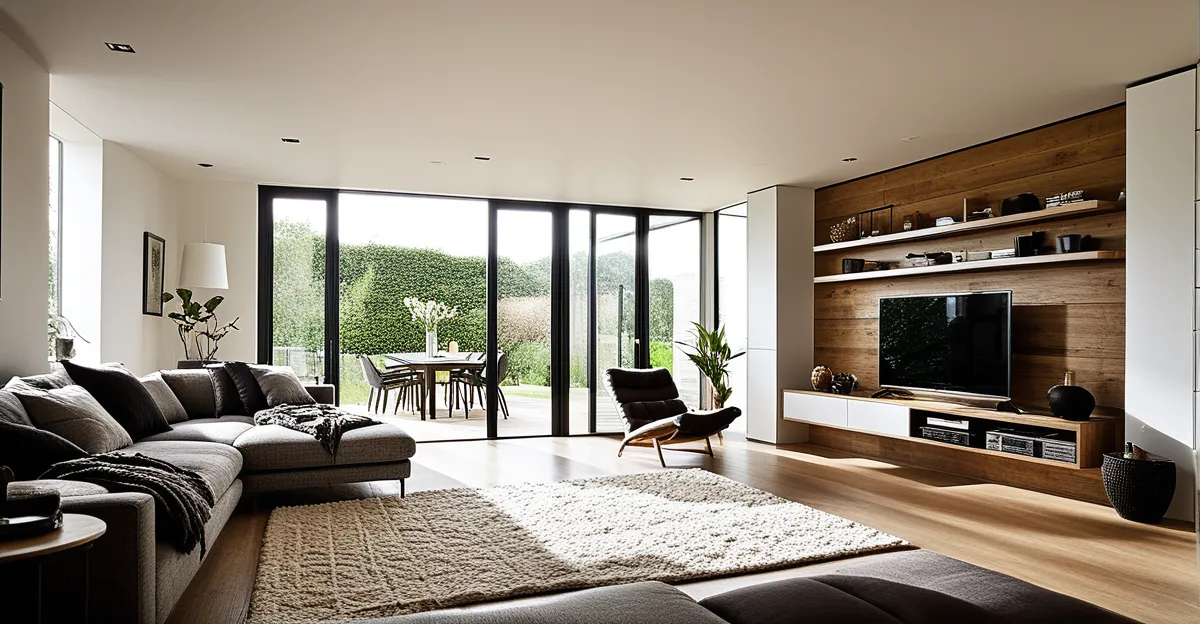The Role of Innovative Home Designs in Daily Life
Innovative home designs offer numerous benefits that cater to both the functionality and aesthetics of a living space. By enhancing comfort through thoughtful layouts, these designs transform homes into sanctuaries where every detail supports a harmonious lifestyle.
One crucial aspect is the increase in functionality through smart storage solutions. Innovative designs amass the ingenuity to conceal clutter, ensuring a more organized space that enhances the living experience. Whether it’s hidden compartments or multipurpose furniture, these solutions promote efficiency and accessibility, making daily activities smoother.
Also read : What are the best ways to optimize space in a UK apartment?
Aesthetic improvements also play a pivotal role in elevating mood and well-being. The strategic use of lighting, color, and texture in these designs can significantly impact a person’s emotional state, providing an environment that nurtures peace and positivity. Through carefully curated elements, homes are transformed into visually appealing sanctuaries that boost mental clarity and relaxation.
In essence, incorporating innovative home designs translates into a lifestyle marked by enhanced comfort, increased functionality, and improved aesthetics, which altogether elevate the quality of daily life.
In the same genre : What Are the Best Ways to Incorporate Sustainable Practices into Your UK Home Living?
Key Features of Innovative Home Designs
Innovative home design features are the backbone of creating spaces that are not only functional but also aesthetically pleasing and futuristic.
Open-Concept Living Spaces
Open-concept living spaces eliminate barriers and promote a seamless flow between different areas of the home. This feature is not just about removing walls; it’s about creating an environment where light and air circulate freely, crafting a more spacious and inviting atmosphere. By integrating kitchen, dining, and living areas, families and friends can enjoy a more inclusive and sociable living experience.
Smart Home Technology Integration
Incorporating smart home technology is an essential feature that bridges innovation with everyday life. This can include lighting systems that adjust based on natural light, climate control settings that learn from your habits, and security systems that ensure peace of mind—all accessible via apps. Such technology offers convenience and can significantly enhance the quality of life by making homes more reactive and personalized to the inhabitants’ needs.
Eco-Friendly Materials and Designs
Utilizing eco-friendly materials in home designs not only contributes to sustainability but also often translates into healthier living conditions. Materials like bamboo flooring, recycled glass tiles, and non-toxic paints are beneficial choices. Coupled with energy-efficient fixtures, these design elements reduce the ecological footprint and promote a healthier indoor environment, reflecting conscientious living aligned with the planet’s well-being.
Examples of Innovative Home Designs
Real-life examples of innovative home designs provide tangible proof of their transformative potential. Case studies not only showcase the application of these designs but also highlight the benefits they bring to daily life.
One exemplary case study features a family home that integrates cutting-edge smart home technology with eco-friendly materials. This home utilizes sensors and automated systems to manage energy consumption efficiently. Homeowners report significant reductions in utility bills and an enhanced lifestyle, all while maintaining a minimal ecological footprint.
Interviews with homeowners further reveal the profound impact of innovative designs. They describe how smart storage solutions and open-concept living spaces have enhanced both aesthetics and functionality. A homeowner noted that the strategic integration of natural light has notably improved their mood and work-from-home productivity.
Before-and-after examples illustrate the remarkable transformative effect of innovative design. By converting traditional rooms into multipurpose spaces, a previously cramped home became a spacious sanctuary. These transformations demonstrate the power of thoughtful layouts in optimizing living conditions and fostering a harmonious environment.
Practical Tips for Implementing Innovative Designs
Innovative home designs are not just about aesthetics; transforming a space requires strategic planning and careful consideration. To begin, assess your current space for design improvements. Evaluate what areas lack functionality, noting any clutter or underutilized spaces. Identifying these areas helps prioritize changes and enhances overall home efficiency.
Budgeting is crucial when planning for renovations and innovative updates. Determine what fits within your financial constraints, considering where high-impact investments can be made. Prioritize upgrades such as smart storage or eco-friendly materials, which provide long-term benefits and contribute greatly to a home’s value.
Decide whether to seek professional advice or opt for DIY options. While professionals offer expertise and a polished finish, DIY projects can be more cost-effective and personalized. Consider your skill level and time availability before choosing the path that best suits your needs. Whether opting for professional help or tackling projects yourself, ensure any decisions align with your lifestyle and enhance the space to fit your vision of an innovative home.
Visual Inspiration for Innovative Home Designs
Drawing inspiration from real-world applications can spark creativity and help envision new possibilities for home transformations. By exploring a portfolio of innovative homes, you gain not only design ideas but also a deeper understanding of how these concepts can translate into your space.
Portfolio of Innovative Homes
Innovative home designs often defy traditional constraints, showcasing unique elements such as adaptive layouts and cutting-edge technologies. A well-curated portfolio can display an array of styles, from minimalistic to eclectic, each offering distinct home design benefits. Take note of how spaces are optimized, combining aesthetics with practicality to create environments that enhance daily living.
Infographics on Design Trends
Infographics provide a visual representation of current trends, emphasizing key features like smart storage, adaptable spaces, and eco-friendly materials. These graphics break down complex ideas into simple visuals, making it easier to identify which innovations align with your personal goals. By absorbing these trends, you can make informed decisions that reflect both contemporary styles and sustainable practices.
Video Walkthroughs of Innovative Spaces
Exploring video walkthroughs offers an immersive experience, showcasing the dynamic home design features in action. Watch as spaces are transformed to enhance comfort, functionality, and aesthetics. This medium illustrates how innovative designs come together to create harmonious living environments. Engage with these visual resources to envision a home that mirrors your aspirations, balancing form and function seamlessly.
Expert Opinions and Insights
Expert opinions on home design trends provide valuable insights that can shape your perspective on contemporary living environments. Architects often highlight the importance of balancing functionality and aesthetics to create spaces that are both beautiful and highly practical. They emphasize integrating innovative home design benefits such as open-concept layouts and eco-friendly materials, which not only enhance the living experience but also contribute to a sustainable future.
The impact of design on mental health and productivity is another crucial focus area. Experts assert that elements like natural light, color palettes, and clutter-free spaces can significantly affect one’s mood and efficiency. For instance, open-concept living areas can reduce stress and improve social interactions, while eco-friendly materials can promote physical health by maintaining indoor air quality.
Looking ahead, experts predict that future home design developments will increasingly incorporate technology. From smart storage solutions to automated systems, the trend towards tech-integrated living is expected to continue. As homes become more adaptable and intuitive, architects believe that these innovations will play a vital role in improving daily life, offering solutions that cater to evolving needs and lifestyle preferences.







